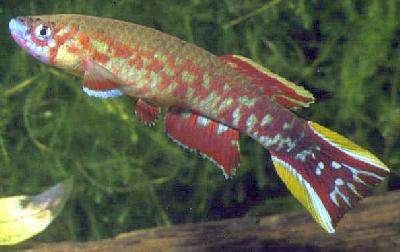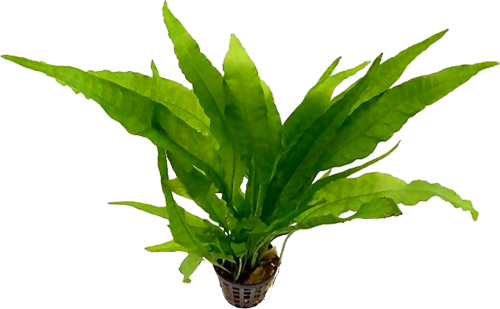On a macro level the notion of species is blatantly obvious: an elephant is an elephant and a hummingbird is a hummingbird - that's quite clear - to us as human observers and to both the hummingbird and the elephant. Each may not have a clue what the other is, but it seems reasonably certain they each know the other is not exactly like they are. The difficulty arises when we have some plant or animal that may, for example, have a large geographic range and may not look or be the same (in some other biological way) throughout that range. Are they all the same species if they look different? Well, they may all interbreed, so they must be the same species right? This is a popular aquarium hobby myth that if two animals interbreed and produce fertile offspring then they are the same species. The thing is this kind of thinking would leave you to believe there is some physical basis for the concept of species - and there just isn't.
Mathematics is also a total fantasy - a synthetic model man had created to help explain his universe (no matter how you believe the universe was created it wasn't because of mathematics, we invented that very much after the fact). Similarly so, the concept of species is something made up by mankind to help explain relationships in living organisms - but it's totally arbitrary and exists solely for human convenience. Of all the species on earth, man is the only one with any concept of species, the rest of those species out there don't know or care. They care about eating and mating, possibly not in that order.
Senior statesman of the hobby Jim Langhammer from the Detroit zoo said it best:
| You previously asked about species "definition". I think you realize that a perfect workable definition CANNOT exist per se. The dimension of "time" alters the systematists view as well as the populations variability. The only workable definition of a species is: a species is the assemblage of TYPE SPECIMENS chosen at the time of the publication of name and description of that species. All other organisms are equated to be either the SAME or different! Ergo, a fish is either similar to or different from a named species. Needless to say some opinions to that end carry more weight than others! |
Does that give you some idea of how arbitrary a species "definition" can be? In a nutshell, some guy says: "these things right here that I collected in such and such a place and which I have deposited in so and so museum or collection I hereby declare to be a species named "something or other". The community associated with this plant or animal can agree or disagree. There is no hearing, no taxonimical equivalent of filing a motion in court, it's just somebody's opinion. When things are good everybody jumps to agreement, recognizing the seminal work of somebody expert in their field, and a consensus forms around this new species or revision of a species or genus or what have you.
To be sure, things don't always work out. Sometimes species are named by accident - first publication counts and even aquarium magazines have over the years become unwitting vehicles of what has turned out to be the first printed description of a new species. Usually species descriptions are published quite intentionally and usually in scientific publications. To be sure, you can define a valid species by printing a description of some type specimens in a local aquarium society bulletin. The problem arises when future scientists attempt to find the referenced work. The formal scientific journals and even magazines such as the one you are reading are easily obtained, but not so the specialty publications of aquarium clubs and national societies.
Sometimes there is near-violent disagreement on a point of taxonomy, and sometimes things are such a mess the name is discarded as "Nomen nudum" which is Latin for "totally bogus" - look at the genus formerly known as Roloffia for example.

You say Scriptaphyosemion I say Roloffia (geryi)
Roloffia is an invalid name, but there is a tremendous amount of support for the name, purely for sentimental reasons: lots of people liked Erhard Roloff, whose articles and photographs graced this magazine in the 60's and 70's. When Genus Roloffia was erected it was done so with an incorrect type specimen and rules of the International Commission on Zoological Nomenclature ("ICZN") declare that an invalid name may not be reused. So, Roloffia as a genus is dead, officially, but you'll still see it used today, especially in Germany where Roloff lived. Appeals to put the name back have been ruled on and rejected, yet in spite of this the name is still used in hobby publications. Roloff was a friend of a friend and even though I know it's wrong, and as a scientist this should bother me but I still refer to the Aphyosemion west of the Dahomey gap as "Roloffia" not the taxonomically pure "Scriptaphyosemion" and "Archaphyosemion". So while most of the world might refer to "Scriptaphyosemion geryi", I still refer to them as "Roloffia geryi". Apparently I'm not as much of a taxonimical pariah as I thought, googling these names yields, as of this writing, 2 hits for Scriptaphyosemion, 11 for Archaphyosemion and nearly 1200 for Roloffia. Perhaps I'm just too easily amused...
Now, interestingly there is a parallel in the plant world. I suspect that many people who cultivate aquatic gardens also have terrestrial gardens and I'll betcha most of you folk know what a Hosta is. Originally they were Hosta, then it was discovered the name was invalid and the genus was changed to Funkia. So many poeple still referred to them as Hosta, that despite an actual ruling that Hosta was invalid,it was made valid by essentially, a variance, because it simply wasn't practical to bury the old name
So, taxonomy represents to a large degree the consensus of the community concerned with it; there may be a few rough spots "around the edges" where species seem to grade into another, but all in all things work out pretty well, and given a Latin name you can usually figure what some organism somebody is talking about. But only to a point - consider: I say "Cryptocoryne wendtii": you really don't know which of what may be 100 different plants I'm actually talking about, and this is where species itself isn't terribly meaningful and the notions of "variety" and "population" have some import.
Say you fly to Sri Lanka to collect Crypts. You keep meticulous records and bring back C. wendtii from four different parts of the country, and that you keep them separate when you grow them at home. You might find one has narrow green leaves, one has short fat olive colored leaves and one has brown, bullate leaves. Yet when they flower they're all unmistakably C. wendtii. What you have here is different populations of the same species. They're not different enough that they warrant classifying them as a different species but they are different enough that we as aquarists want to keep them distinct. This happens with many of our groups of fishes: cichlids, livebearers, killies and so on and so forth. This might help to explain what "all those weird names are" when you see some poor plant or critter with a Latin name two to three times longer than it is itself.
The way you tell the location apart from the Latin name is easy - the Latin name must always be italicized and the location name must be in quotes. For example" Cryptocoryne wendtii "Mi Oya". One nasty side effect of the computer age is it's not always possible to use italics online and when it is lotsa people don't italicize the Latin name. Do though, if you can.
Which brings us to "variety". This is simply to identify some sort of tank raised population that is in some way different from others of the species. Think of the "marble queen" variety of swordplant. It's the same species as "regular" swordplant but just like poodles are different from German shepards and Siamese cats are different from tabbies they are all different varieties of the same specs. We usually refer to these as "breeds" when talking about dogs and cats but it's the same thing.
So now if you see something like Cryptocoryne wendtii "Mi Oya" "red" you'll know it's a red variety of the population from Mi Oya of Cryptocoryne wendtii.
 Java fern |  Windelow variety of java fern |
People go to a lot of trouble to keep species with known location points reproductively isolated from others of their species from different or unknown (read "aquarium strain") locations. Why? Because somewhere along the line some poor soul went trekking through some jungle, usually at a fairly high cost, to go and find and, even harder, bring back alive some small piece of tropical flora or fauna for us to enjoy. Even if a named location of some plant or fish is otherwise identical in all outward appearances it must still be kept reproductively isolated from others of it's species. No exceptions! If you lose one sex you absolutely cannot use a similar but not exactly the same species. Well, you can but what you have now is an "aquarium strain" which in and of itself has some value, but not as much in all likely hood as the original named population.